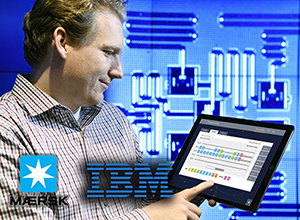Two blue chip players in today's global supply chain marketplace announced that they plan to introduce a “transformational” service designed to expedite ocean cargo shipping and mitigate risk.
Maersk, which recently partnered with Alibaba—a Chinese e-commerce provider—is now joining IBM in a widely celebrated effort to introduce blocktrain technology linking shippers, freight forwarders, other ocean carriers, ports and customs authorities.
The blockchain solution based on the Hyperledger Fabric and built by IBM and Maersk is designed to help manage and track the paper trail of tens of millions of shipping containers across the world by digitizing the supply chain process from end-to-end to enhance transparency and the highly secure sharing of information among trading partners. When adopted at-scale, the solution has the potential to save the industry billions of dollars, says Maersk.
“We expect this to not only reduce the cost of goods for consumers, but also make global trade more accessible to a much larger number of players from both emerging and developed countries,” said Ibrahim Gokcen, chief digital officer, Maersk.
In an interview with LM, analysts noted that the Danish super carrier is positioned to identify the best ocean lanes for the initial launch of this collaboration.
“Maersk will certainly know where the potential choke points are in the supply chain,” says Martha Bennett, Principal Analyst at Forrester Research, London, UK. “The regulatory barriers will also have to be addressed,” she says.
Just how soon this strategy will be implemented is “the $64 million dollar question,” says Bennett.
There are other questions, she adds.
“Then there's the industry ‘buy in' to consider. How many other ocean carriers will want to join? Finally there's the getting of official approval.”
Bennett is optimistic about the deal, however and feels that once the “solicitation for participation” has been made, real traction will move it forward.
Bridget van Kralingen, senior vice president, Industry Platforms, IBM is even more bullish on the prospects. She told LM that the blockchain can potentially provide “massive savings” when used broadly across the ocean shipping industry “ecosystem.”
In a nutshell, this is how it works:
*Each participant in a supply chain ecosystem can view the progress of goods through the supply chain, understanding where a container is in transit. They can also see the status of customs documents, or view bills of lading and other data.
*Detailed visibility of the container's progress through the supply chain is enhanced with the real time exchange of original supply chain events and documents.
No one party can modify, delete or even append any record without the consensus from others on the network.
*This level of transparency helps reduce fraud and errors, reduce the time products spend in the transit and shipping process, improve inventory management and ultimately reduce waste and cost.
The solution enables the real time exchange of original supply chain events and documents through a digital infrastructure, or data pipeline, that connects the participants in a supply chain ecosystem.
“We are not terribly concerned about government regulators creating obstacles for its implementation,” said van Kralingen. “They are not in the business of making money, after all. They just want to ensure that we are providing another layer of security and financial settlement.”
SC
MR


Latest Supply Chain News
- Services sector sees growth in October, reports ISM
- Balanced supply chain management Part 4: The key—leading beyond the silo
- Managing inbound freight: What has changed in two decades?
- Inbound freight: Often a missed opportunity
- Aggregators sitting on the throne of Africa’s e-commerce supply chains: What lessons can we learn?
- More News
Latest Resources

 Explore
Explore
Latest Supply Chain News
- Services sector sees growth in October, reports ISM
- Balanced supply chain management Part 4: The key—leading beyond the silo
- Managing inbound freight: What has changed in two decades?
- Inbound freight: Often a missed opportunity
- Aggregators sitting on the throne of Africa’s e-commerce supply chains: What lessons can we learn?
- Cross-border transport 2024: Navigating the surge
- More latest news
Latest Resources

Subscribe

Supply Chain Management Review delivers the best industry content.

Editors’ Picks





